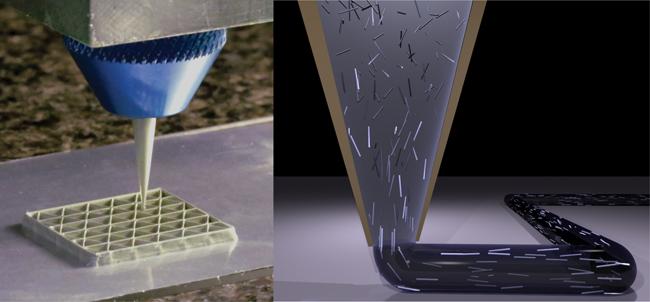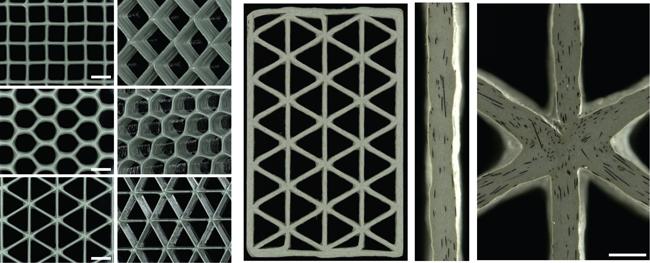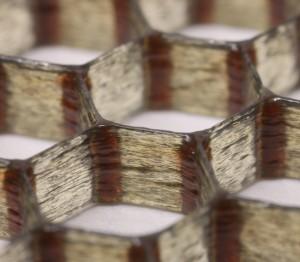3D printing processes have been undertaken using materials such as thermo plastics and UV-curable resins, but now materials scientists from Harvard’s School of Engineering and Applied Sciences have teamed up with the Wyss Institute for Biologically Inspired Engineering to create a printable epoxy-based thermosetting resin. These epoxies allow for the printing of materials to be used as structural components in lightweight architecture. These new 3D inks are composed of epoxy resins combined with nanoclay platelets for enhanced viscosity and a dimethyl methylphosphonate compound. To this mixture two fillers are added, silicon carbine and carbon fibers.
The directionality of those fillers in the ink controls the versatility and strength of the printed material. This particular mixture creates a composite that is adjustable in terms of strength and toughness and that is approximately 200% stronger than the best printed polymer composites currently available. The description of the research was published in the article “3D-Printing of Lightweight Cellular Composites” in an issue of Advanced Materials co-authored by Brett Compton and Jennifer Lewis.
 Lorna Gibson, professor of materials science and mechanical engineering at MIT explained the significance of the research:
Lorna Gibson, professor of materials science and mechanical engineering at MIT explained the significance of the research:
“This paper demonstrates, for the first time, 3D printing of honeycombs with fiber-reinforced cell walls. Of particular significance is the way that the fibers can be aligned, through control of the fiber aspect ration – the length relative to the diameter – and the nozzle diameter. This marks an important step forward in designing engineering materials that mimic wood.”
Why would it be important to be able to mimic wood in this way? After all, we already have wood, right?
A primary potential application for this ink is in the creation of structural honeycomb for use inside the blades of wind turbines. Currently, the insides of these blades are made using sandwiched construction materials, one of which is balsa wood. While balsa is a fast-growing tree that has been identified as a rapidly renewable resource, it does have grain variations that can make it difficult to make it meet the precise performance requirements set for such products. In addition, balsa wood is relatively expensive and as the length of the blades used in these wind turbines increases, even now there are some nearing 250 feet in length, the cost and need for precision grows as well. Using this ink and 3D extrusion printing techniques, the researchers have been able to create cellular composite materials that actually improve on balsa wood.
It’s not just wind turbines that may benefit from this new ink, as fuel efficiency requirements in the automotive industry have become stricter, a strong lightweight material such as this may be just what designers need to help their cars these requirements. Compton sees an exciting future made possible with this epoxy:
“As we gain additional levels of control in filler alignment and learn how to better integrate that orientation into component design, we can further optimize component design and improve materials efficiency. Eventually, we will be able to use 3D printing technology to change the degree of fiber filler alignment and local composition on the fly.”
 Future research plans for the team include exploring thermosetting resins that have precisely aligned and blended fillers as potential materials for both their structural and conductive capabilities. What other uses could such a material have? Discuss this story in the 3D printed epoxy composite forum thread on 3DPB.com.
Future research plans for the team include exploring thermosetting resins that have precisely aligned and blended fillers as potential materials for both their structural and conductive capabilities. What other uses could such a material have? Discuss this story in the 3D printed epoxy composite forum thread on 3DPB.com.
Subscribe to Our Email Newsletter
Stay up-to-date on all the latest news from the 3D printing industry and receive information and offers from third party vendors.
Print Services
Upload your 3D Models and get them printed quickly and efficiently.
You May Also Like
3D Printing News Briefs, June 11, 2025: Sustainability, Automotive Tooling, & More
We’re starting with sustainability news in today’s 3D Printing News Briefs, as EOS has strengthened its commitment on climate responsibility, and Zestep is making 3D printing filament out of eyewear...
3D Printing 50 Polymer Stand-In Parts for Tokamaks at the PPPL & Elytt Energy
Of all the world’s things, a tokamak is one of the hardest, most complex, expensive and exacting ones to make. These fusion energy devices make plasma, and use magnets to...
3D Printing News Briefs, May 17, 2025: Color-Changing Materials, Humanoid Robot, & More
We’re covering research innovations in today’s 3D Printing News Briefs! First, Penn Engineering developed 3D printed materials that change color under stress, and UC Berkeley researchers created an open source,...
Firehawk Aerospace Partners with JuggerBot 3D, Gets $1.25M from AFWERX for 3D Printed Propellants
Texas-based Firehawk Aerospace, an advanced energetic materials firm that works with aerospace and defense applications, announced a strategic partnership with JuggerBot 3D, an Ohio-based large-format 3D printer manufacturer. Together, the...


































